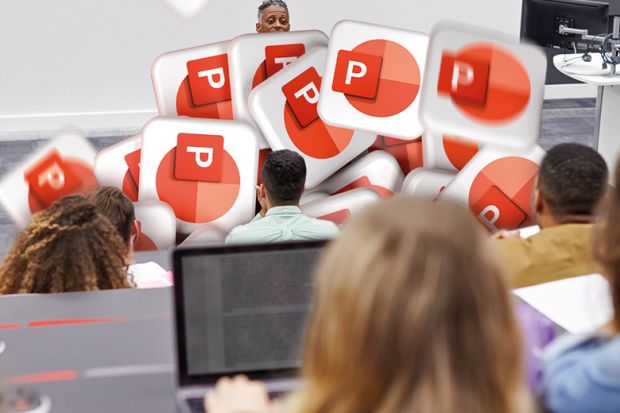“Death by PowerPoint” may be a common peril in academic conferences, but in the academic classroom the greatest threat to learning is posed by students’ increasing tendency to live by PowerPoint.
Digital slides undeniably provide convenient ways to organise and deliver lecture materials for both educators and students. But most guidelines suggest that, to avoid killing people’s attention with excessive text, slides should contain no more than three bullet points and 20 words, supplemented with pictures, graphics, clips and sound.
In my lectures, I used to follow those principles. However, the students’ feedback was rather surprising. While the content of my lectures was recognised as interesting and my slides regarded as aesthetically appealing (and not visually overwhelming), some students commented that they did not provide enough information for exam preparation.
What this revealed to me is that lecturers’ slides, which we are asked to provide on our institutions’ virtual learning environment, are being used by students as a replacement for finding independent pathways through the material.
Obviously, there are several problems with this. No slide deck, however deathly detailed, could be an adequate substitute for completing the required reading, doing the thinking and then writing up your findings and conclusions. Moreover, if students are relying on slides rather than listening to what lecturers say, they are failing to gain aural academic literacy. They are failing to learn how to take notes by identifying and summarising the most important information: the necessary first steps to becoming independent learners.
I am very sympathetic to universities’ aspirations to enrich students’ learning experience with technology. However, making slides available is exacerbating the wider post-pandemic issue of students disengaging from the active, social learning process by, for instance, staying away from lectures and relying on digital catch-up. It is an example of the great risk that, rather than enhancing the teaching and learning process, educational technology simply replaces it with counterproductive spoon-feeding.
To avoid this risk, I now provide only foundational materials in my lecture slides and only make about half of them available on our VLE. This requires students to attend the lectures (which are not recorded) to benefit from the slides, facilitating a consciousness of being part of a bigger learning community that boosts their engagement and commitment to their studies.
Each lecture starts with the big question of the topic in question, followed by a series of slides that address this question by presenting figures taken directly from research papers, to which there is a clear reference, and usually one sentence summarising the main finding. My aim is to help students orient themselves within the reading and teaching materials but still encourage them to do independent learning – although I am mindful of recent meta-analyses that have revealed that teaching with slides actually has no additional effect on cognitive assimilation over and above lecturing without slides. At best, slides do only a minor part of the teaching work.
Either way, my experience demonstrates that it is vital to explain to the students the pedagogical reasons for delivering the lecture in this form. They need to appreciate, for instance, that it is not a result of lecturer laziness; it may not be obvious to them that this form of delivery is actually much more demanding. I make clear that I am not trying to be difficult but to help them learn the important skills of taking notes, reading advanced literature, and managing vast amounts of information: skills that will benefit them in the future workplace.
They generally accept that rationale. What has surprised me is the pushback I get from some in educational circles. There are two main reasons for this. First, people worry that using lecture slides in this stripped-back form creates discrepancies between modes of delivery between lecturers. But I am very dismissive of this concern: surely educators should have the freedom to choose the appropriate method of delivery of their teaching?
The second doubt is more worrying. Some educators simply do not believe that students can cope with my method. They are fully aware of students’ increasing reliance on lecture slides rather than lecture notes but wish to facilitate this shift because they no longer believe that students can develop independent learning strategies.
If we allow our enthusiasm for ill-judged technological shortcuts, alongside our low expectations of students, to undermine learning and skills development, we will leave them ill prepared for a technology-driven world in which mundane tasks will be done by AI and in which humans’ market value will rely on their superior ability to research and innovate.
A university teacher’s role is to create a supportive community that celebrates and rewards the place of genuine high-order learning in preparing people for such a knowledge-based society. Pandering to students’ expectations that the materials provided on our slides should be sufficient to pass the final assessment is a dereliction of that duty.
Tobiasz Trawiński is lecturer in psychology at Liverpool Hope University.
Register to continue
Why register?
- Registration is free and only takes a moment
- Once registered, you can read 3 articles a month
- Sign up for our newsletter
Subscribe
Or subscribe for unlimited access to:
- Unlimited access to news, views, insights & reviews
- Digital editions
- Digital access to THE’s university and college rankings analysis
Already registered or a current subscriber? Login








